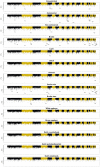Signatures of selection in the genomes of commercial and non-commercial chicken breeds
- PMID: 22384281
- PMCID: PMC3287981
- DOI: 10.1371/journal.pone.0032720
Signatures of selection in the genomes of commercial and non-commercial chicken breeds
Abstract
Identifying genomics regions that are affected by selection is important to understand the domestication and selection history of the domesticated chicken, as well as understanding molecular pathways underlying phenotypic traits and breeding goals. While whole-genome approaches, either high-density SNP chips or massively parallel sequencing, have been successfully applied to identify evidence for selective sweeps in chicken, it has been difficult to distinguish patterns of selection and stochastic and breed specific effects. Here we present a study to identify selective sweeps in a large number of chicken breeds (67 in total) using a high-density (58 K) SNP chip. We analyzed commercial chickens representing all major breeding goals. In addition, we analyzed non-commercial chicken diversity for almost all recognized traditional Dutch breeds and a selection of representative breeds from China. Based on their shared history or breeding goal we in silico grouped the breeds into 14 breed groups. We identified 396 chromosomal regions that show suggestive evidence of selection in at least one breed group with 26 of these regions showing strong evidence of selection. Of these 26 regions, 13 were previously described and 13 yield new candidate genes for performance traits in chicken. Our approach demonstrates the strength of including many different populations with similar, and breed groups with different selection histories to reduce stochastic effects based on single populations.
Conflict of interest statement
Figures


References
-
- Rubin C, Zody MC, Eriksson J, Meadows JRS, Sherwood E, et al. Whole-genome resequencing reveals loci under selection during chicken domestication. Nature. 2010;464:587–591. - PubMed
-
- Darwin C. The Variation of Animals and Plants under Domestication. Macmillan Publishers Limited 1868
Publication types
MeSH terms
Substances
LinkOut - more resources
Full Text Sources

